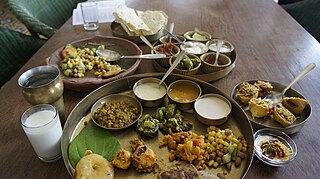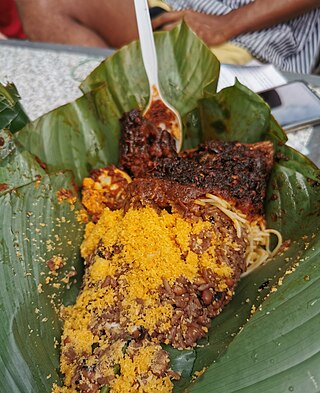Related Research Articles

Glutinous rice is a type of rice grown mainly in Southeast and East Asia, and the northeastern regions of South Asia, which has opaque grains, very low amylose content, and is especially sticky when cooked. It is widely consumed across Asia.

The black-eyed pea or black-eyed bean is a legume grown around the world for its medium-sized, edible bean. It is a subspecies of the cowpea, an Old World plant domesticated in Africa, and is sometimes simply called a cowpea.

Malay cuisine is the traditional food of the ethnic Malays of Southeast Asia, residing in modern-day Malaysia, Indonesia, Singapore, Brunei, Southern Thailand and the Philippines as well as Cocos Islands, Christmas Island, Sri Lanka and South Africa.

Ugali, also known as posho, nsima, and other names, is a type of corn meal made from maize or corn flour in several countries in Africa. It is cooked in boiling water or milk until it reaches a stiff or firm dough-like consistency. In 2017, the dish was added to the UNESCO Representative List of the Intangible Cultural Heritage of Humanity, one of a few foods in the list.

Gujarati cuisine is the cuisine of the Indian state of Gujarat. The typical Gujarati thali consists of rotli, dal or curry, rice, and shaak. The thali will also include preparations made from pulses or whole beans such as moong, black eyed beans etc., a snack item (farsaan) like dhokla, pathra, samosa, fafda, etc. and a sweet (mishthaan) like mohanthal, jalebi, sevaiya etc.

A rice cake may be any kind of food item made from rice that has been shaped, condensed, or otherwise combined into a single object. A wide variety of rice cakes exist in many different cultures in which rice is eaten and are particularly prevalent in Korea and Japan. Common variations include cakes made with rice flour, those made from ground rice, and those made from whole grains of rice compressed together or combined with some other binding substance.

Moin-moin ( Yoruba) or moi-moi is a steamed or boiled bean pudding made from a mixture of washed and peeled beans and onions, fresh red peppers, spices, and often fish, eggs, and/or crayfish. It is a protein-rich Yoruba food that is commonly eaten across West Africa.

The cuisine of the Democratic Republic of the Congo and the Republic of the Congo varies widely, representing the food of indigenous people. Cassava, fufu, rice, plantain and potatoes are generally the staple foods eaten with other side dishes.

Ghanaian cuisines refer to the meals of the Ghanaian people. The main dishes of Ghana are organized around starchy staple foods, which goes with either sauce or soup accompanied with a source of protein. The main ingredients for the vast majority of soups and stews are; tomatoes, hot peppers and onions. Most Ghanaian soups and stews are red or orange in appearance as a result of the main ingredients used.

Kue is an Indonesian bite-sized snack or dessert food. Kue is a fairly broad term in Indonesian to describe a wide variety of snacks including cakes, cookies, fritters, pies, scones, and patisserie. Kue are made from a variety of ingredients in various forms; some are steamed, fried or baked. Kue are popular snacks in Indonesia, which has the largest variety of kue. Because of the countries' historical colonial ties, Koeé (kue) is also popular in the Netherlands.

West African cuisine encompasses a diverse range of foods that are split between its 16 countries. In West Africa, many families grow and raise their own food, and within each there is a division of labor. Indigenous foods consist of a number of plant species and animals, and are important to those whose lifestyle depends on farming and hunting.

Nigerian cuisine consists of dishes or food items from the hundreds of Native African ethnic groups that comprise Nigeria. Like other West African cuisines, it uses spices and herbs with palm or groundnut oil to create deeply flavored sauces and soups.

Javanese cuisine is the cuisine of Javanese people, a major ethnic group in Indonesia, more precisely the province of Central Java, Yogyakarta and East Java.

A great variety of cassava-based dishes are consumed in the regions where cassava is cultivated, and the ingredient is included many national or ethnic specialities.

Manipuri cuisine refers to the cuisine of Manipur, a state of northeastern India. Daily meals are based on rice, with a few side dishes of vegetables, fish and meat. A meal would usually have a vegetable stew called ensaang or athongba, flavored with dried or fried fish; stir-fried vegetables called kanghou; and a spicy item, which could be morok metpa, eromba, or singju. All piquant side dishes are accompanied by a choice of fresh herbs, collectively called maroi. The base and essence of Meitei cuisine is the fermented fish called ngari. Several dishes of meat, mostly chicken and pork, are cooked with unique recipes. As a result of religious taboos, however, the Meitei Pangals do not cook the latter.

Malaysian Indian cuisine, or the cooking of the ethnic Indian communities in Malaysia, consists of adaptations of authentic dishes from India, as well as original creations inspired by the diverse food culture of Malaysia. Because the vast majority of Malaysia's Indian community are of South Indian descent, and are mostly ethnic Tamils who are descendants of immigrants from a historical region which consists of the modern Indian state of Tamil Nadu and Sri Lanka's Northern Province, much of Malaysian Indian cuisine is predominantly South Indian inspired in character and taste. A typical Malaysian Indian dish is likely to be redolent with curry leaves, whole and powdered spice, and contains fresh coconut in various forms. Ghee is still widely used for cooking, although vegetable oils and refined palm oils are now commonplace in home kitchens. Before a meal it is customary to wash hands as cutlery is often not used while eating, with the exception of a serving spoon for each respective dish.

Waakye is a Ghanaian dish of cooked rice and beans, commonly eaten for breakfast or lunch. However, others eat it for supper. The rice and beans, usually black eyed peas or cow beans, are cooked together, along with red dried sorghum leaf sheaths or stalks and limestone. The sorghum leaves and limestone give the dish its characteristic flavor and a red appearance and the sorghum is taken out before consumption. The word waakye is from the Nigerian Hausa language and means beans. It is the contracted form of the full name shinkafa da wake which means rice and beans.

Wasawasa is a popular dish, eaten in Dagbon and other parts of Northern Ghana. It is also eaten in some West African countries, such as Burkina Faso. It is made from dried yam peelings called jaling, which have been grounded into flour and steamed. Wasawasa is mostly eaten with spicy sauces and sometimes garnished with vegetables, accompanied with shea butter or raw groundnut oil and fried fish. Wasawasa is sometimes served with beans, pasta, and salad.

Funge or fúngi (Angola) or mfundi is a traditional African swallow made of cassava flour whisked into boiling water. It can also be made with sorghum, maize, or millet. It can be served with textured vegetable, fish, or meat stew, as well as other vegetable, meat, and fish dishes. Funge is a staple food in African cuisine. Some richer and more flavorful versions may be made with stock, like fish stock, instead of water. It is also known as bidia.
References
- ↑ Roberts, L, Jeff. "Optimal pH for Bananas" . Retrieved 21 December 2021.
- ↑ "Ghana, Food & Drinks". www.ghanaweb.com. Retrieved 2020-05-17.
- ↑ "NEWS". miczd.gov.gh. Retrieved 2020-05-17.
- ↑ "Tuo Zaafi and Tubaani, 18 Junction, Spintex Road, Accra (2020)". www.findglocal.com. Retrieved 2020-05-17.
- ↑ "Health benefits of tubaani (tumbaani)". Zongo Republic. 2020-02-20. Retrieved 2020-06-06.
- 1 2 Gamor, Gladys; Kyei Akoto-Danso, Edmund; Karg, Hanna; Chagomoka, Takemore (2015). Traditional Recipes from the Northern Region of Ghana. Taiwan: AVRDC – The World Vegetable Center. p. 10. ISBN 92-9058-210-3.
- ↑ "NEWS". miczd.gov.gh. Retrieved 2020-06-06.